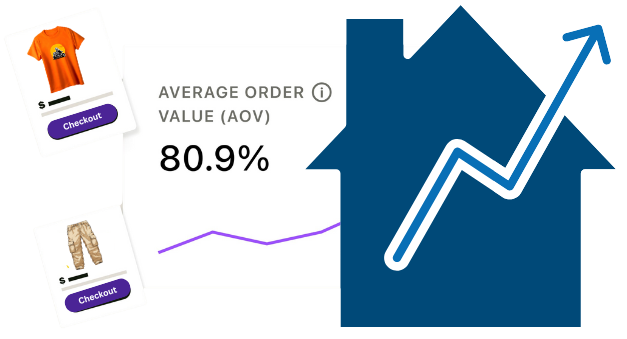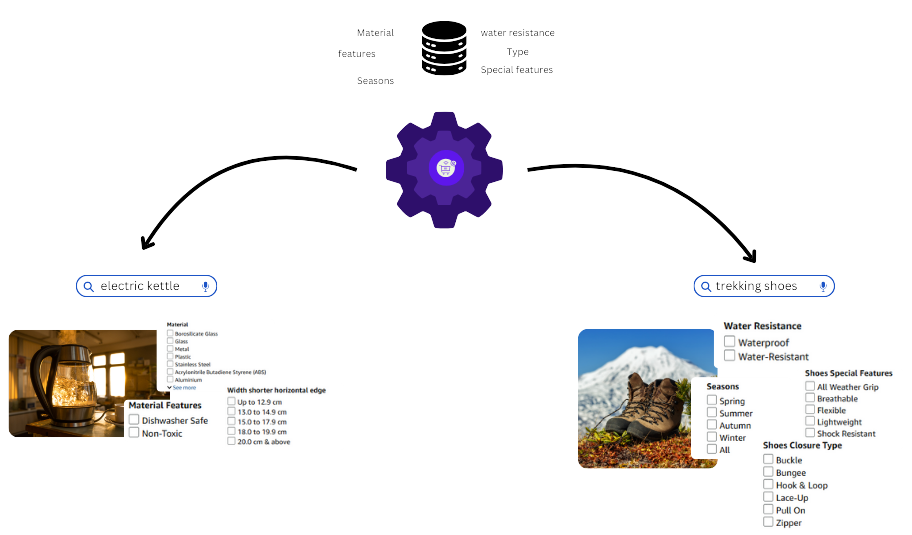
In today’s fast-paced online shopping world, customers want to find the right product quickly and effortlessly. Imagine stepping into a huge store with no signs or sections—finding what you need would be frustrating. That’s exactly why faceted search is a game-changer in e-commerce.
Faceted search helps shoppers filter products based on specific attributes like price, brand, size, or color. It acts like a personal shopping assistant, narrowing down options to match individual preferences. Instead of scrolling through hundreds of irrelevant results, customers can simply apply filters—like “blue, medium-size, cotton shirt”—to find exactly what they need in seconds.
Traditional keyword search often overwhelms shoppers with too many results, leading to frustration and lost sales. Faceted search improves the shopping experience, making it faster, more efficient, and enjoyable—ultimately boosting conversion rates for businesses.
In this blog, we’ll dive into how faceted search works, its impact on customer satisfaction, and why every e-commerce store should implement it for higher sales and happier shoppers.
Table of contents
- Understanding Faceted Search: A Smarter Way to Shop Online
- The Business Impact of Faceted Search: Why It’s a Must-Have for E-Commerce
- How Faceted Search Works: A Technical Overview
- Best Practices for Effective Faceted Search: Enhancing Usability & Performance
- Real-World Examples of Faceted Search in E-Commerce: How Industry Leaders Get It Right
- AI and Machine Learning in Faceted Search
- Future Trends in Faceted Search: The Next Evolution in E-Commerce
- Conclusion
Understanding Faceted Search: A Smarter Way to Shop Online
In the fast-paced world of e-commerce, customers expect to find what they need quickly and effortlessly. This is where faceted search comes in—a powerful filtering system that allows shoppers to refine their search based on specific attributes like price, color, brand, size, and ratings. Instead of endlessly scrolling through products, customers can narrow down their options in seconds, making their shopping experience smoother and more efficient.
What is E-commerce Faceted Search?
Faceted search goes beyond basic filtering by allowing shoppers to refine search results using multiple attributes at once. Whether it’s selecting a brand (Nike, Adidas), size (9, 10, 11), or color (black, white, blue), ensures customers only see products that match their exact preferences.
Unlike traditional filters that may return zero results if a combination doesn’t exist, faceted search dynamically updates the available options. This means if a size or color isn’t in stock, the system automatically adjusts the filters, preventing frustrating dead ends.
Example: A customer shopping for shoes can filter by:
- Brand – Nike, Adidas, Puma
- Size – 9, 10, 11
- Color – Black, White, Blue
With each selection, the available options update instantly, ensuring a frictionless shopping experience.
How Does Faceted Search Differ from Traditional Filters?
While both faceted search and traditional filters aim to refine product selections, they function very differently:
Traditional Filters:
- Apply rigid rules, which can result in no matches if the combination doesn’t exist.
- Often require users to reset their search and try again manually.
Faceted Search:
- More flexible and dynamic, allowing customers to mix and match attributes effortlessly.
- Prevents dead ends by automatically adjusting available options based on inventory.
This user-friendly approach keeps shoppers engaged and reduces frustration, leading to higher conversions and a better shopping experience.
Key Components of Faceted Navigation:
- Product Attributes: These characteristics of products, such as price, color, brand, size, and material, help customers quickly narrow their search to meet specific criteria.
- Dynamic Filtering: Customers can select different facets, and the available options update in real-time. For instance, choosing a brand may automatically adjust available sizes or colors based on inventory.
- Search Query Refinement: Faceted search allows customers to start with a broad term and progressively refine results by applying multiple facets, making it easier to find the exact product they want without sifting through unrelated items.
According to the Baymard Institute, e-commerce sites with well-implemented faceted search see significantly higher conversion rates. By offering a more intuitive shopping experience, businesses can increase sales while keeping customers satisfied.
By leveraging faceted search, online stores can transform the way customers browse and buy, ensuring a seamless shopping journey from start to checkout.
The Business Impact of Faceted Search: Why It’s a Must-Have for E-Commerce
Faceted search isn’t just about improving the shopping experience—it has a direct impact on business success. By helping customers quickly find the right products, it boosts conversion rates, engagement, and sales while reducing bounce rates. Let’s explore how implementing faceted search can transform your e-commerce platform.
Increases Conversion Rates
When customers can easily filter products based on their preferences—like size, color, brand, or price—they are more likely to find exactly what they need and make a purchase.

- Faster product discovery reduces frustration.
- Higher relevance in search results leads to quicker decision-making.
- Proven results – A study found that detailed filtering options in e-commerce, especially in furniture retail, significantly increased conversions.
Why It Matters: A smooth and efficient search experience reduces drop-offs and turns more visitors into paying customers.
Enhances User Engagement & Session Duration
Faceted search keeps shoppers engaged longer by offering an intuitive and effortless way to refine searches.

- When customers can quickly find relevant products, they’re more likely to browse further.
- A longer session duration means higher chances of discovering additional products.
- The easier the search, the more likely customers are to return, strengthening brand loyalty.
Why It Matters: A well-implemented faceted search encourages customers to explore more, increasing the likelihood of purchases.
Reduces Bounce Rates
A high bounce rate often indicates frustration—users can’t find what they’re looking for and leave the site. Faceted search fixes this by making searches more precise and relevant.

- Customers stay on your site longer instead of bouncing to a competitor’s store.
- More relevant results = less frustration = a better shopping experience.
- Shoppers don’t have to sift through hundreds of irrelevant products, keeping them engaged.
Why It Matters: A lower bounce rate means more satisfied customers and higher chances of converting visits into sales.
Boosts Average Order Value (AOV)
Faceted search does more than just help customers find what they need—it encourages them to explore complementary and higher-end products.

- Customers discover related products through refined searches.
- Dynamic filtering highlights premium options they may not have considered.
- A tailored search experience leads to bigger shopping carts and higher revenue per customer.
Why It Matters: Strategic filtering nudges customers toward larger purchases, increasing your store’s profitability.
SEO Benefits
Faceted search can boost your site’s SEO by creating optimized, long-tail search pages that attract organic traffic.

- Well-structured filtering generates indexable pages that rank for specific search queries.
- Targeted pages help reach the right audience searching for detailed product attributes.
- But be cautious—improper faceted navigation can create duplicate content issues, which should be managed with proper SEO strategies.
Why It Matters: A properly optimized improves search engine visibility, bringing more organic traffic and potential buyers to your store.
Incorporating search into your e-commerce platform not only elevates the customer experience but also delivers tangible business benefits, from higher conversion rates to improved SEO performance.
How Faceted Search Works: A Technical Overview
Indexing and Structuring Product Data
To enable faceted search, it’s essential to organize your product information systematically. This involves assigning specific attributes—such as price, color, brand, size, and material—to each product. By categorizing products using structured metadata, you create a foundation that allows customers to filter and find items based on these characteristics.

For example, an online clothing store might tag each item with attributes like “red,” “cotton,” “medium,” and “brand name” to facilitate precise filtering.
Search Engines and Databases
Choosing the right search engine is crucial for handling faceted searches efficiently. Popular options include Elasticsearch, Solr, and Algolia, each offering robust features tailored for e-commerce needs.
- Elasticsearch: An open-source search engine known for its scalability and real-time search capabilities. It allows for complex querying and supports various data types, making it suitable for large product catalogs.
- Solr: Built on Apache Lucene, Solr is another open-source search platform that offers advanced faceting capabilities. It’s designed for high-volume traffic and provides extensive customization options.
- Algolia: A hosted search service that emphasizes speed and relevance. Algolia provides a user-friendly interface and is known for its quick implementation process, making it a popular choice for businesses seeking rapid deployment.
Each platform handles faceted search by indexing product attributes and enabling dynamic filtering based on user-selected facets. The choice among them depends on your specific requirements, technical expertise, and scalability needs.
Query Processing
When a customer selects specific facets to filter products, the system processes these selections to retrieve relevant results. This involves constructing queries that consider the chosen attributes and searching the indexed data to find matching products. Efficient query processing ensures that users receive accurate and fast search results, enhancing their shopping experience.
Dynamic Faceting
Dynamic faceting refers to the system’s ability to adjust available filters based on the current product selection and inventory status. For instance, if a customer filters for “blue” shirts, the system might dynamically update the available sizes and brands based on what’s in stock. This real-time adjustment prevents customers from selecting facets that would lead to zero results, thereby reducing frustration.
Performance Optimization
Handling large product catalogs and multiple simultaneous users requires careful performance optimization. Key strategies include:
- Caching: Storing frequently accessed data temporarily to reduce retrieval times. For example, caching popular search queries can significantly speed up response times for users.
- Pagination: Paginating search results improves load times and user navigation, preventing information overload and enhancing the overall experience.
- Query Optimization: Optimize search queries to reduce processing time and resource use. Indexing key fields and refining database queries enhance the efficiency of complex searches.
Best Practices for Effective Faceted Search: Enhancing Usability & Performance
A well-implemented faceted search system can make shopping faster, easier, and more intuitive—but only if it’s set up correctly. To maximize its effectiveness, businesses must focus on relevance, usability, and performance. Here are the best practices to optimize faceted search for a seamless e-commerce experience.
Keep Facets Relevant and Useful
Facets should simplify product discovery, not overwhelm users with excessive options.
- Prioritize Essential Filters: Offer filters that align with your customers’ primary decision-making criteria, such as price, brand, size, and color. Avoid overwhelming users with too many options.
- Avoid Redundant or Unnecessary Facets: Ensure each facet provides unique value. Redundant filters can clutter the interface and confuse shoppers.
Use Hierarchical Categories for Better Organization
A structured, easy-to-navigate faceted search makes product browsing intuitive and efficient.
- Implement Nested Facets: Organize facets in a hierarchical structure, allowing users to drill down into subcategories. For example, under “Clothing,” provide sub-facets like “Men,” “Women,” and “Kids.”
- Facilitate Intuitive Navigation: A well-structured hierarchy helps users understand the product catalog and find desired items more efficiently.
Optimize for Mobile Usability
With mobile shopping on the rise, search must be fully responsive and easy to use on small screens.
- Design Responsive Filters: Ensure that facets are easily accessible on mobile devices. Use collapsible menus and touch-friendly controls to enhance the mobile shopping experience.
- Maintain Performance: Optimize loading times and ensure that applying filters doesn’t cause delays, as mobile users expect quick responses.
Enable Multi-Select Filters
Shoppers often have multiple preferences—faceted search should accommodate this flexibility.
Allow Multiple Selections: Let users select multiple options within a facet (e.g., choosing both “Red” and “Blue” under color). This flexibility helps shoppers find products that meet multiple criteria.
- Display Applied Filters Clearly: Show selected filters prominently and provide an easy way to remove or adjust them.
Use Analytics to Refine Facets
Faceted search should evolve based on user behavior and product trends.
- Monitor User Behavior: Analyze which facets are frequently used and which are ignored. This data can guide adjustments to make facets more relevant.
- Continuously Improve: Regularly update facets based on customer feedback and changing product offerings to keep the search experience optimal.
Improve Performance with Caching and Indexing Techniques
A fast and efficient faceted search ensures a seamless shopping experience.
- Implement Caching Strategies: Cache frequently accessed facet configurations to reduce server load and improve response times.
- Optimize Indexing: Ensure your product database is well-indexed to handle complex queries efficiently, especially as your catalog grows.
By implementing these best practices, businesses can reduce friction in product discovery, increase conversions, and create a shopping experience that customers love.
Real-World Examples of Faceted Search in E-Commerce: How Industry Leaders Get It Right
Many of the biggest names in e-commerce have perfected faceted search to help customers find products faster, stay engaged, and make informed purchases. By offering intuitive filtering options, these platforms provide a seamless shopping experience that drives higher sales and customer satisfaction. Let’s take a look at how some of the industry giants utilize faceted search to their advantage.
Amazon
Amazon employs an advanced faceted search system that enables users to refine their product searches efficiently. For instance, when searching for “laptops,” customers can filter results by brand, price range, processor type, screen size, customer ratings, and more. This comprehensive filtering system helps users quickly narrow down options to find the product that best suits their needs.
eBay
eBay’s faceted search allows users to conduct precision searches through multi-layered filtering. For example, a search for “vintage watches” can be refined by brand, year of manufacture, condition, price range, and location. This layered approach helps buyers find specific items in eBay’s vast marketplace.
Zappos
Zappos offers a user-friendly faceted search experience, particularly for shoes and apparel. Customers can filter products by size, width, color, brand, price, and even customer ratings. This intuitive filtering system ensures shoppers can easily find items that match their style and fit preferences.
Best Buy
Best Buy’s faceted search is tailored to enhance the electronics shopping experience. When searching for “smartphones,” users can filter results by brand, price, features (such as camera quality or storage capacity), carrier compatibility, and customer ratings. This specific filtering helps customers make informed decisions on complex products.
These examples illustrate how effective implementation of faceted search can significantly improve the user experience on e-commerce platforms. By adopting faceted search best practices, e-commerce businesses can enhance the customer journey, boost sales, and stay ahead in a competitive market.
AI and Machine Learning in Faceted Search
Artificial Intelligence (AI) and Machine Learning (ML) are revolutionizing faceted search, making it smarter, more dynamic, and highly personalized. By analyzing user behavior and preferences, AI-powered faceted search helps shoppers find what they need faster, improving engagement, conversions, and overall satisfaction. Here’s how AI enhances faceted search to create a more seamless and intuitive shopping experience.
AI-Driven Faceting
AI enhances faceted search by learning from user interactions. For example, if a shopper frequently filters by “organic” products, the system can prioritize this facet in future searches. This dynamic adjustment makes finding desired items quicker and more efficient.
Predictive Search Suggestions
Machine learning algorithms predict what users might be looking for based on past behavior. As a user types a query, the system offers suggestions that align with their interests, streamlining the search process.
Personalized Faceted Navigation
By analyzing individual preferences, AI customizes the facets presented to each user. For instance, a user who often shops for eco-friendly products might see “sustainable materials” as a prominent filter option. This personalization enhances the shopping experience, making it more engaging and tailored to individual needs.
By integrating AI and machine learning into faceted search, e-commerce businesses can stay ahead of the competition, providing a smarter, more intuitive shopping experience that drives growth and customer loyalty.
Future Trends in Faceted Search: The Next Evolution in E-Commerce
As technology continues to advance, faceted search is evolving beyond traditional filtering. Innovations like voice search, visual search, and AI-powered chatbots are transforming how customers discover and refine products online. These cutting-edge trends will make shopping more intuitive, engaging, and personalized than ever before.
Voice-Activated Faceted Navigation
With the rise of voice assistants like Amazon’s Alexa and Google Assistant, shoppers are increasingly using voice commands to search for products. Integrating voice search with faceted navigation allows customers to refine their searches verbally. For instance, a shopper might say, “Find red running shoes under $100,” and the system will apply the relevant filters automatically. This hands-free approach makes shopping more convenient and accessible.
Visual Search Integration
Visual search enables customers to upload images to find similar products. Combining this with faceted search allows users to start with a photo and then narrow down results using filters. For example, after uploading a picture of a dress, a shopper can filter by size, color, or brand to find the perfect match. This fusion of visual and faceted search enhances product discovery and caters to shoppers seeking specific items.
Conversational Commerce with AI Chatbots
AI-powered chatbots are becoming more sophisticated, guiding users through the shopping process in a conversational manner. These chatbots can ask clarifying questions to understand customer preferences and apply faceted filters dynamically. For instance, a chatbot might inquire about preferred brands, price ranges, or specific features, adjusting the product recommendations accordingly. This interactive experience makes online shopping feel more personalized and engaging.
By adopting these next-gen faceted search features, e-commerce businesses can enhance user experience, boost engagement, and drive higher conversions in the digital-first world.
Conclusion
Faceted search is no longer just a nice-to-have feature—it’s an essential tool for any e-commerce business aiming to enhance product discoverability and streamline the shopping experience. By enabling customers to quickly refine their searches, faceted search reduces frustration, increases engagement, and ultimately drives higher conversion rates. A well-implemented faceted navigation system doesn’t just help users find what they need—it keeps them coming back.
Beyond simple filtering, faceted search creates a more intuitive and personalized shopping experience. By leveraging the right strategies and tools, businesses can boost customer satisfaction, improve retention, and accelerate long-term growth. Now is the perfect time to evaluate and refine your faceted search system—your customers will appreciate the convenience, and your business will reap the rewards.
For more expert insights on search technology and optimization, explore our latest blogs:
- BM25 or TF‑IDF? Find Out Which Drives Better Search Results
- Mastering Semantic Search: How Vector Databases Transform Information Retrieval for Business Success
- What Are Elasticsearch Refresh Interval? A Complete Guide to Optimization
- LlamaIndex Document Indexing: Unlock Faster, Smarter Content Retrieval

